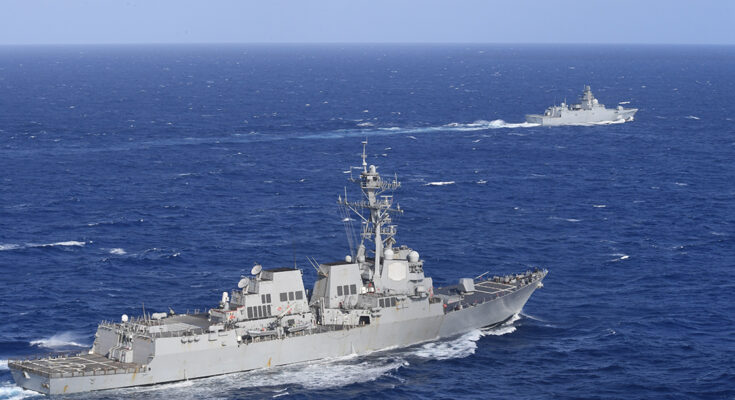THE WATCH STAFF
President Vladimir Putin hailed a Russian Navy frigate departing from the Northern Fleet’s home port of Severomorsk in January 2023 as having no equal. Equipped with Russia’s most sophisticated sea-based Tsirkon hypersonic missile system, the frigate set out on a global voyage to join naval vessels from China and South Africa for a joint military exercise in February.
The warship produced sensational headlines, which Russia used for propaganda as a signal to the United States and its NATO allies.
The reality is much different.
The Russian frigate, the Admiral Gorshkov, is being continuously monitored, tracked and contested by the U.S. Navy as it crosses the areas of responsibility for the Department of Defense’s joint combatant commands — from U.S. European Command (EUCOM) to U.S. Northern Command (USNORTHCOM) to U.S. Southern Command (SOUTHCOM). These commands are part of a Globally Integrated Layered Defense, or GILD, network that spans both geography and domains such as air, land, sea and space, according to USNORTHCOM, which emphasizes that “out-of-area operations” by the Russian military in its area of responsibility will be challenged in support of homeland defense. Each combatant command has the ability to select from multiple maritime responses at a moment’s notice, which include conventional naval or Naval Special Warfare Operations.
(Pictured: The U.S. Navy Arleigh Burke-class guided missile destroyer USS Gravely shadows the Russian guided-missile frigate Adm. Gorshkov in the Atlantic Ocean. Gravely is underway in support of USNORTHCOM maritime homeland defense activities. Also pictured: U.S. Navy SEALs and Naval Special Warfare crewman train for maritime rapid response.)
“U.S. Northern Command is aware and monitoring the presence of the Russian Navy vessel in the Atlantic Ocean. We won’t speculate on hypotheticals or discuss future operations. As part of our normal daily operations, we closely monitor and track maritime activity in the region,” USNORTHCOM said in a statement after Reuters reported January 25 that the frigate conducted a computer-simulated Tsirkon launch in the Atlantic, which would put a missile hypothetically in range of the U.S.

“Although this kind of activity is not new for Russia, we remain vigilant, ready, and capable to counter any threat that risks destabilizing this peaceful region and hemisphere.” (In 2019, a U.S. warship shadowed the same Russian frigatewhen it made a similar long voyage, which included a stop in Cuba and transit in the Straits of Florida.)
In other words, although this may be a high-profile event for the Russian Navy, it is business as usual for U.S. Naval Forces Northern Command (NAVNORTH), USNORTHCOM’s maritime component.
Retired Vice Adm. Mark Norman, the former commander of the Royal Canadian Navy, explained to CTV National News how monitoring of the Russian frigate is a coordinated effort among NATO allies. Norman said the undertaking would likely include tracking by satellite and aircraft as well as shadowing by surface vessels.
Indeed, in the Norwegian Sea, a P-3 Orion maritime patrol aircraft from the Royal Norwegian Air Force spotted the frigate. In the Mediterranean, the Portuguese Navy met it. When the frigate passed the narrowest point of the English Channel — the Strait of Dover — while sailing south toward the Atlantic, the Royal Navy’s HMS Portland shadowed it, according to a January 12 story in England’s Daily Mail newspaper. When it entered the Bay of Biscay near the Atlantic on January 12, the French frigate Bretagne and a maritime patrol aircraft started the watch, according to a January 15 story by the aviation news website AeroTime.
Of course, the U.S. Navy took the baton in the western Atlantic when the USS Gravely assumed shadow operations. The seamless tracking and hand-off of the Russian “out-of-area deployer” reflected statements made by the leader of NAVNORTH, Adm. Daryl Caudle, when he assumed command a little more than a year ago.
“We will own the Atlantic — meaning three things,” Caudle said. “First, a guarantee that the homeland will be defended. Second, we will operate our forces without seams or artificial boundaries through command and control structures that are nimble, agile, responsive and mission-based. Finally, our adversaries will think more than just ‘not today’ with respect to attacking the United States, but it will be the absolute wrong day to confront our Navy.”
Such joint and cross-command integration demonstrates the seamless ability of the U.S. and its allies to deter threats and prevent provocations or attacks before they begin, according to USNORTHCOM.
Don’t believe the hype
So, what of the frigate’s hypersonic missiles? The few details available are of questionable accuracy.
Russia places the Tsirkon’s range at 900 to 1,000 kilometers, defense website 19FortyFive said in a story August 24, 2022, while “others believe that it is several hundred kilometers lower.”
The website, addressing state media claims that the Tsirkon “reached speeds of up to Mach 8 in tests,” said that experts in the West think its “actual maximum speed to be closer to Mach 5.”
Kristian Åtland, a senior research fellow with the Norwegian Defense Research Establishment, told The Barents Observer newspaper January 25 that the frigate’s exercise in the Atlantic was “probably meant to send some sort of signal to the U.S. and NATO.”
But experts said the signal was more publicity than power projection.
“The Russian Navy is clearly in a disadvantaged position in this part of the Atlantic, and activities like these are unlikely to deter anyone,” Åtland said, according to The Barents Observer. “The presence of a Russian frigate, accompanied by one or two support vessels, hardly qualifies as a display of force.”

